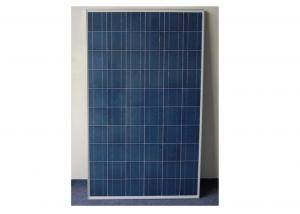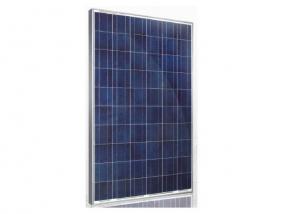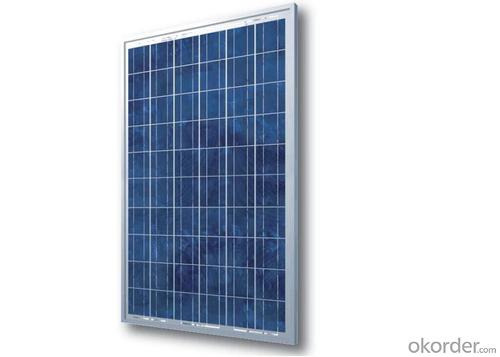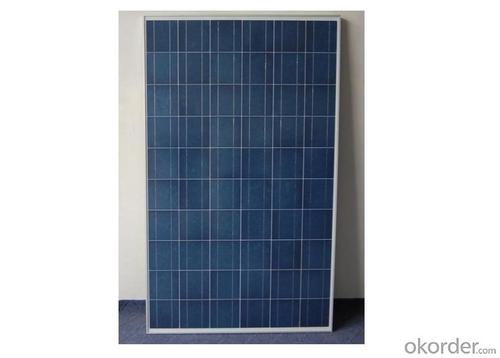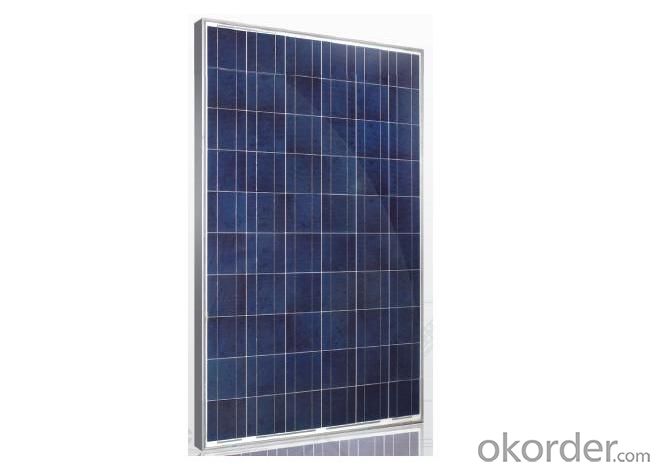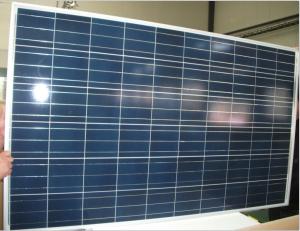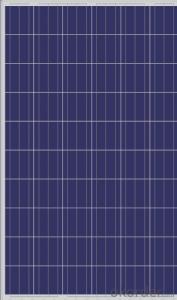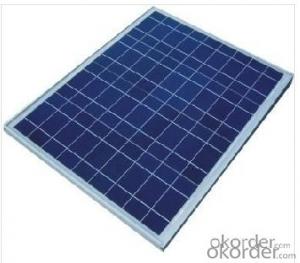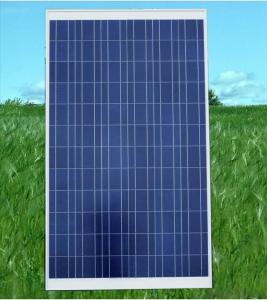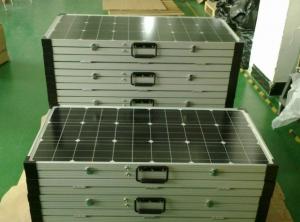Poly Solar Panels CNBM (250W-260W)
- Loading Port:
- China Main Port
- Payment Terms:
- TT or LC
- Min Order Qty:
- 1 pc watt
- Supply Capability:
- 10000 pcs per month watt/month
OKorder Service Pledge
OKorder Financial Service
You Might Also Like
Introduction of Poly Solar Panels CNBM (250W-260W)
Poly Solar Panels CNBM (250W-260W) is designed for large electrical power requirements. It is the optimal choice for both on-grid and off-grid power systems. CNBM Solar panel offers high performance of power per square foot of solar array. Poly Solar Panels CNBM (250W-260W) of Monocrystalline silicon(c-Si): often made using the Czochralski process. Single-crystal wafer cells tend to be expensive, and because they are cut from cylindrical ingots, do not completely cover a square solar cell module without a substantial waste of refined silicon.If you have interest in Poly Solar Panels CNBM (250W-260W) ,please contact us!
Characteristics of Poly Solar Panels CNBM (250W-260W)
I.Solar Cell : High efficiency crystalline solar cell. Even if under the weak light, the solar module can produce maximum power output.
II.Tempered glass (toughened glass): Anti-reflecting coating and high transmission rate glass increase the power output and mechanical strength of solar module.
III.EVA and TPT: Using high quality EVA and TPT to prevent destroying and water.
IV.AI frame: Without screw, corner connection. 6 holes on the frame can be installed easily.
V.Junction box: Multi function junction box with water proof.
VI.Long lifetime: ≥25 years; Less power decrease.
VII.Good performance of preventing from atrocious weather such as wind and hails.
VIII.Resisting moisture and etching effectively, not effected by geology.
IX.The certificate issued by international authority: UL, TUV, IEC, VDE, CE.
Standard Test Conditions of Poly Solar Panels CNBM (250W-260W)
The opto-electrical specifications shown below are stabilized values being measured at Standard Test Conditions, Irradiance: 1000W/m2, Spectrum: AM1.5 at 25°C, The info below is subject to manufacturing tolerances. Where appropriate minutes of measurement are available and are used for the dimensioning of the installation.
Advantages of Poly Solar Panels CNBM (250W-260W)
• CNBM Solar performance guarantees for 25 years
• 10 years guarantee for workmanship
• Timeliness of delivery
• Quality Products certified (TÜV, UL, CE, VDE, ISO)
CNBM International Corporation's products including Monocrystalline Solar Panel, Polycrystalline Solar Panel have received and enjoyed famous reputation in many countries and regions in the world .As a solar panel manufacturer in China, we strive to provide our customers with excellent service, superior products and unmatched value.
Datasheet of Poly Solar Panels CNBM (250W-260W)
Characteristics of Poly solar panels CNBM (250W-260W) | |||
Max Power Voltage Vmp(V) | 30.1 | 30.2 | 30.4 |
Max Power Current Imp(A) | 8.32 | 8.44 | 8.55 |
Open Circuit Voltage Voc(V) | 37.5 | 37.6 | 37.7 |
Short Circuit Current Isc(A) | 8.87 | 8.99 | 9.10 |
Max Power Pm(W) | 250 | 255 | 260 |
Temperature Coefficient of Cells of Poly Solar Panels CNBM (250W-260W) | |
NOCT | 45℃ ± 2℃ |
Temperature Coeffucients of Isc (%/℃) | 0.0492 |
Temperature Coeffucients of Voc (%/℃) | -03374 |
Temperature Coeffucients of Voc (%/℃) | -0.4677 |
Mechanical Data of Poly Solar Panels CNBM (250W-260W) | |
Dimension | 1638 × 982 × 40 mm |
Weight | 19.5 kg |
No. of Cells and Connections | 60 (6 ×10) |
Tolerance | 0 ~ + 5 W |
Cell | Monocrystalline Cell 156 × 156 mm |
Packing | 720 Pcs/40ft(H) Container |
Limits of Poly Solar Panels CNBM (250W-260W) | |
Operating Temperature | -40℃ to +85℃ |
Storage Temperature | -40℃ to +85℃ |
Max System Voltage | 1000VDC(IEC) / 600VDC(UL) |
Guarantees of Poly Solar Panels CNBM (250W-260W) | |
Products Guarantee | 10 yrs free from defects in materials and workmanship |
Performance Guarantee | No less than 90% within 10yrs and no less than 80% within 25yrs |
Certificates | TUV(IEC61215&IEC61730),VDE(IEC61215&IEC61730),UL,CE |
IV Curve of Poly Solar Panels CNBM (250W-260W)

The data does not refer to a single module and it is not part of the offer
It is only for comparison only to different module types.
Test Conditions of Poly Solar Panels CNBM (250W-260W)
The opto-electrical specifications shown below are stabilized values being measured at Standard Test Conditions, Irradiance: 1000W/m2, Spectrum: AM1.5 at 25°C, The info below is subject to manufacturing tolerances. Where appropriate minutes of measurement are available and are used for the dimensioning of the installation.
Picture 1. The Factory Indoor Sight of Poly Solar Panels CNBM (250W-260W)
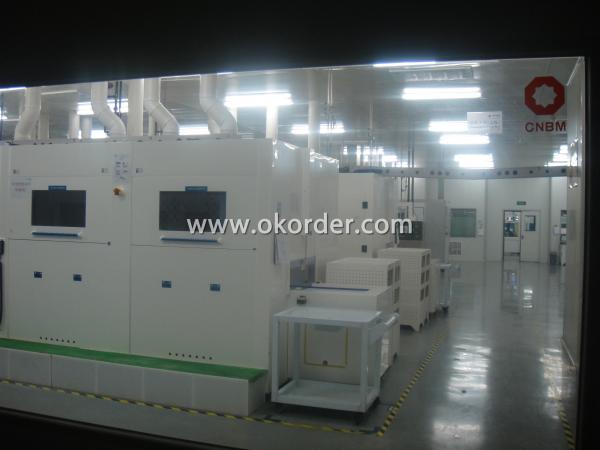
Picture 2 The Package of Poly Solar Panels CNBM (250W-260W)
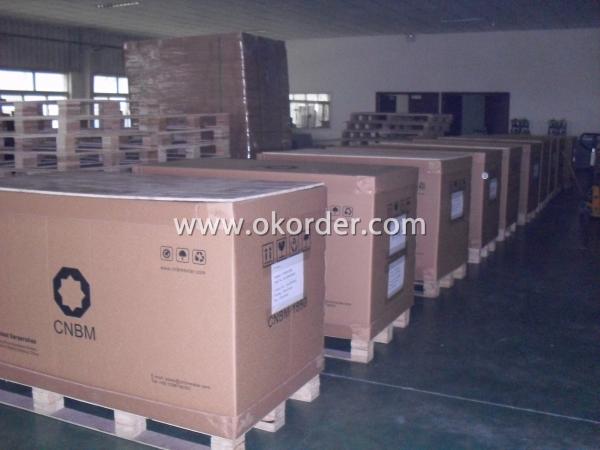
- Q: The first panel is located in New England, the second is placed in the Sahara desert, the third is on the Earth side of the moon, and the last is on the far side of the moon. Which panel would absorb the most sunlight over a year's time and why ? All the panels are place in optimal places where they would get the most light available.
- Best to worst- ) The Earth side of the Moon 2) Sahara Desert 3) New England 4) Far side of the Moon
- Q: if car companies install solar panels on cars, like in all the car were the sun can reach that would reduce the consumption of gas in the summer, and might save some energy for winter and if that energy is not enough they can use gas or electricity i think that would be a lot of savings, and less contamination i don't know that is my idea what do you people think?
- There okorder Part of the problem of putting solar panels on a vehicle is that at almost no time is the orientation for the panels correct. You would not consider putting solar panels on the shady side of your house, or not tilted and aimed properly. This is because solar panels are expensive and you would like to make sure that they are as efficient as possible. A better plan may be to put solar panels on your house and buy an electric car. Have the panels feed power into the grid during the day where you can be paid at the higher daytime rates and then charge your vehicle at the lower night time rates from the grid.
- Q: I contend:As far as the solar panels causing global warming I'll try to explain. If you put a black panel on the ground or on your house and don't connect it to anything, it will absorb solar energy (heat) during daylight and release it at night (radiation). The net heat gain is zero. If you hook up a solar panel in the same place but hook it up to batteries, charge the batteries during sunlight hours and using that energy to electrically heat the home at night. The panels will absorb solar energy during the day but will convert that to electrical energy in the batteries instead of radiating it back into space at night. The result is a net gain in earth's temperature.Right or wrong?
- One piece of technology: Hydro-energy storage. Pump water up to an artificial lake at the top of a mountain to store energy, and then let the water run down through turbines to retrieve the energy later, eliminating most or all of the need for batteries. Usually this stuff saying renewables suck is BS when you actually try. Yet another method, are solar power towers which last longer than solar panels and continue to generate energy at night. While a non-universal storage method, it's good for storing the sun's energy in the mechanism that generates the power. According to some studies, they are the best option next to wind turbines. I'll describe a particular model. A field of mirrors beams light to a part of the tower which contains salt, for it's incredible heat storage capacity when molten. In turn, the heat from that region heats water which spins some turbines, generating lots of energy. Currently, the best models continue to generate electricity at night and for a few consecutive cloudy days. I think whoever was saying that was probably trying to delay response. There are too many ways around that to be true, and saying that it contributes more to Global Warming than fossil fuels is a lie. This is why some government intervention is needed: The companies aren't responding to new ideas, and they happen to often be fossil fuel companies as well. If you don't create the environment where it lowers fossil fuel consumption, then they win because prices stay high.
- Q: I have purchased a 2 volt LED lantern from argos, it comes with a built in 6 volt 4ah sealed acid battery. What I wanted to know is would I be able to charge it using my 6 volt solar panel?
- If it has a 6 volt battery- is it marked 2 volts on an external plug? If so, there is a resistor inside to drop the potential the battery sees. The battery itself could be slipped out and recharged easily from your 6 volt panel. Just determine how much current (in Amps or Milliamps) the panel produces nominally and divide that into 4 and add one fourth of that length of time to make up for system losses. This will tell you how many hours it should charge assuming your starting voltage of the battery is above .5 volts. and the panel is at 3 volts potential or higher. So if your panel puts out amp at 0AM, you would charge for 5 hours. 4 divided by is 4 and one fourth of that is so 4 plus is 5. It is a little more involved than that, but as a rule of thumb. Also do not discharge tha lantern to the point of no light output. LEDs are efficient, but their current will add up. If it is suggest to be able to use the lantern for up to 8 hours on a charge, stick to that value. Lead acid batteries have best longevity when discharged only to 80 percent capacity. Once battery is charged- disconnect from charging source.
- Q: I have 2 20 watt Solar panel. I have it hooked up to solar controller and batteries to inverter. Am trying to figure out how much watts am getting. I found the voltage but how do I find the amp reading on a mutimeter?
- It is possible your meter does not have the capacity to safely measure more than 300 milliamps which is too small to measure current output from solar panels. Assuming no losses in the system or components, if your meter does not have the capacity to measure 0 Amps, you will need to get one that does. Analogs are better than digitial for this. Most often the 0 Amp circuit of the meter has a discrete positive plug location for the positive test lead. Most have a common ground connection with the rest of the meter functions. If you are measuring current at the battery in the charge mode- Negative lead of meter goes to positive terminal of battery and positive lead of meter goes to the cable that was connected to the positive terminal of the battery. Since the Wattage is a nominal measurement, if you measure between the panel and controller, take measurement on one leg of the panel, as you want to measure the current with the loaded active circuit. Meter is oriented the same way as the measurement at the battery would be made above only this time the meter is between the panel and controller. At peak solar conditions, expect current to be measured at 2.5 to3 Amps or more per panel. Under optimal conditions your panel will have higher output than their ratings indicate. Open circuit can be close to 20 volts. Never short circuit the output of the solar panels. It is volts multiplied by amps that gives you Watts.
- Q: If i wanted to get a 5 KW solar Panel does it mean it produces 5KW a day/hour/year!?!?i need 2555.35KW a week and i don't know how many or what kind of solar panels i need.Please somebody help me
- I'm absolutely no expert within the field but hope to be trained rather more in the future. I am in the infancy stage of discovering as many choices as possible in the design and construction of a total inexperienced condo. That being stated, a distinctive nearby news story sparked my interest after they investigated the price effectiveness of residential sunlight panel systems. Here in Austin, Texas, through subsidies and incentives furnished, which you could set up a system that costs roughly 22.5k for about 7. It appears these deductions come from a federal incentive (which is a very small component) combined with those set by means of the city itself. Austin is an attractive modern city so I imagine their incentives maybe just a little higher than most however which you can call your city's common information line (3) and do a little more digging. Yet another option you might have is renting the equipment. I used to be advised the day gone by that a manufacturer here on the town would enable for the set up and use for a month-to-month rate. I know how tight cash will also be in school and 7 thousand might now not be tangible. The whole trouble of vigour conservation is so conventional nowadays that new information is constantly popping out. Give your current energy supplier a call and see what they may be able to inform ya. I am hoping you in finding anything that works for you. -G
- Q: How much would it cost (approximately) to convert my home (3 bed. 2 bath) to a green home that is run entirely upon solar panels on my roof? From the panels through installation does anyone know a price break down?
- the st element to comprehend is that there is no longer something complicated some photograph voltaic panel. this is not something greater beneficial than a selection of of photograph voltaic or PV cells on a board this is suited for the main spectacular area of your abode, generally on the roof. There are publications obtainable that coach you the thank you to construct a photo voltaic panel and a windmill for basically $a hundred and fifty, and it’s truly difficulty-free to make. appropriate of all, you may save 70% or greater on your potential invoice, including as much as hundreds of dollars each and each 2 months in reductions. I reviewed the two unfastened publications and paid publications and have arise with our ideal to construct your individual photograph voltaic panels.
- Q: I riped two solar panels out of some solar light and tested them. I found out that they both produce 2 volts(I have no idea on the watts or amps). Iquot;ve hooked them up to an electric motor that can be driven by a AA battery, but when I hook the solar panels up to them nothing happens. What is wrong?
- Mark G has a good answer. If you leave your voltmeter on the solar cells when you hook up the motor, you will see the voltage drop to near zero. Same thing would happen if you tried to use 2 9 volt batteries to start your car. They just cant maintain the voltage when high curent demands are made.
- Q: are there solar panel that work without the sun?
- Unfortunately, okorder
- Q: How do solar panels and heaters work?
- well, I suggest you that Amaze-Heaters are good for you.
Send your message to us
Poly Solar Panels CNBM (250W-260W)
- Loading Port:
- China Main Port
- Payment Terms:
- TT or LC
- Min Order Qty:
- 1 pc watt
- Supply Capability:
- 10000 pcs per month watt/month
OKorder Service Pledge
OKorder Financial Service
Similar products
Hot products
Hot Searches
Related keywords

